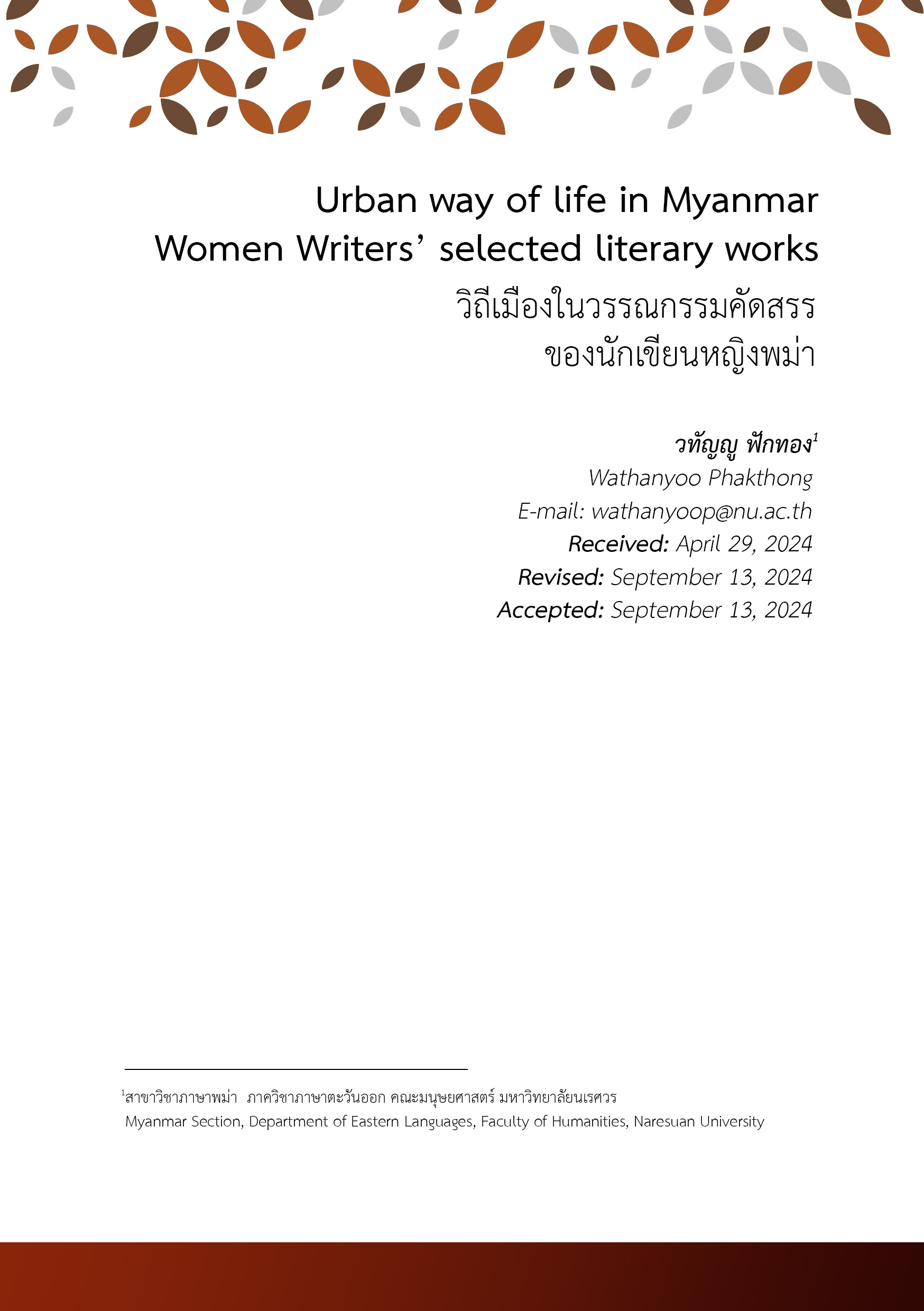วิถีเมืองในวรรณกรรมคัดสรรของนักเขียนหญิงพม่า วิถีเมืองในวรรณกรรมคัดสรรของนักเขียนหญิงพม่า
Main Article Content
บทคัดย่อ
การเลือกสรรวรรณกรรมเรื่อง Bawa Eai-met Pann Eai-met (Reality and Illusion) ของ Ma Sandar และเรื่อง Mya Sein Pyar Kamaryut (Emerald Green and Blue Kamaryut) ของ Nu Nu Yi (Innwa) เพื่อศึกษาวิถีชีวิตในเมือง ย่างกุ้งผ่านกรอบทฤษฎีเมืองสมัยใหม่ มีพื้นฐานมาจากการนำเสนอมุมมองที่โดดเด่นเกี่ยวกับพื้นที่ส่วนตัวและวิถีชีวิตในเมือง งานเขียนดังกล่าวให้ข้อมูลเชิงลึกที่มีคุณค่าเกี่ยวกับการนำเสนอพื้นที่ส่วนตัว โดยเฉพาะอย่างยิ่ง การเน้นให้เห็นว่าพื้นที่ส่วนตัว อย่างเช่น อาคารอพาร์ตเมนต์ มีบทบาทสำคัญในการสร้างปฏิสัมพันธ์และความสัมพันธ์ระหว่างตัวละคร นับตั้งแต่สภาฟื้นฟูกฎหมายและระเบียบของรัฐ (SLORC) ได้พัฒนาเมืองอย่างรวดเร็ว โดยอนุมัติการก่อสร้างอาคารที่พักอาศัย เพื่อตอบสนองต่อการเติบโตของเมือง ส่งผลให้อาคารอพาร์ตเมนต์และคอนโดมิเนียมผุดขึ้นมาเป็นจำนวนมากในเมืองย่างกุ้ง กลายเป็นลักษณะที่เรียกกันว่า “city’s skyline” ซึ่งเป็นเอกลักษณ์ของเมืองและเปลี่ยนแปลงภูมิทัศน์เมือง อย่างไรก็ตาม ตรงกันข้ามกับแนวโน้มของเมืองสมัยใหม่ทั่วโลก วิถีเมืองย่างกุ้งกลับมิได้สนับสนุนความเป็นส่วนตัวของตัวละครในพื้นที่ส่วนตัว เห็นได้จากการลดทอนความเป็นส่วนตัวของตัวละคร ตามที่เน้นในงานวรรณกรรมของ Ma Sandar และ Nu Nu Yi (Innwa) แม้ว่าพื้นที่เหล่านี้ได้รับการออกแบบมา เพื่อส่งเสริมความเป็นส่วนตัวและการแยกตัว แต่พื้นที่เหล่านี้กลับทำให้ตัวละครรู้สึกสูญเสียความเป็นส่วนตัวในพื้นที่ส่วนตัวของพวกเขา การมีปฏิสัมพันธ์และกิจกรรมของตัวละครในพื้นที่ส่วนตัว อย่างอาคารอพาร์ตเมนต์และคอนโดมิเนียม ตัวละครได้ต่อรองและกำหนดอัตลักษณ์ของเมืองสมัยใหม่ โดยนำวิถีชีวิตแบบชุมชนชนบทมาปรับใช้ ซึ่งมีอิทธิพลต่อการพัฒนาภูมิทัศน์เมือง พื้นที่ส่วนตัวของผู้อยู่อาศัยแสดงลักษณะต่าง ๆ เช่น เป็นพื้นที่แบบชุมชนที่สอดคล้องกับพื้นที่สาธารณะมากขึ้น การสร้างการผสมผสานระหว่างพื้นที่ส่วนตัวและวิถีชีวิตแบบดั้งเดิมหรือรูปแบบชุมชนชนบทในการวางผังเมือง ซึ่งส่งเสริมความรู้สึกของชุมชนชนบทและการแบ่งปันประสบการณ์ร่วมกันในหมู่ผู้อยู่อาศัย
Downloads
Article Details

อนุญาตภายใต้เงื่อนไข Creative Commons Attribution-NonCommercial-NoDerivatives 4.0 International License.
เอกสารอ้างอิง
Albrecht, M. C. (1954). The relationship of literature and society. American Journal of Sociology, 59, 425–436. doi: 10.1086/221388
Choi, J. (2006). The Metropolis and Mental Life in the Novel. New Literary History, 37 (4), 707-724.
Föllmer, M. (2020). The sociology of individuality and the history of urban society. Urban History, 47(2), 311-326. doi: 10.1017/S0963926819000877
He, W., et al. (2022). Asia aging: demographic, economic, and health transitions. US Department of Commerce, Washington, DC, USA, Report(P95/22), 1.
Ju. (2003). Kyama Chit Thaw Myo (The City, I Love). Yangon: Ju Sarpay.
Khamyang, K. (2009). Urban way of life in the works of Prabda Yoon. (Master's Thesis). Chulalongkorn University, Bangkok.
Mumford, L. (1983). The Culture of Cities. New York: Harcourt.
P. Yangon. (2022). Yangon, a city tragically halted from its long-awaited development and transformation. Retrieved from https://teacircleoxford.com/politics/yangon-a-city-tragically-halted-from-its-long-awaited-development-and-transformation/
Sandar, M. (2014). Bawa Eai-met Pann Eai-met (Reality and Illusion). (4th ed.). Yangon: Parami Sarpay.
Simmel, G. (1971). The Metropolis and Mental Life. In D. N. Levine (Ed.), On Individuality and Social Forms: Selected Writings (pp. 324-339). Chicago: University of Chicago Press.
Wirth, L. (1938). Urbanism as a Way of Life. The American Journal of Sociology, 44 (1), 1-24.
Yi, N. N. Innwa. (1993). Mya Sein Pyar Kamaryut (Emerald Green and Blue Kamaryut). Yangon: Arr Man Thit.


